Ethnic, Authentic, and Exhilarating
A platter of new cookbooks and food writing from indie publishers covers many ethnic traditions and diets, but all the books have a common theme of getting back to healthy, traditional ingredients and techniques–from LA taquerias to artisan salamis to go-to guides on making homemade kimchi and hot sauces.
YumUniverse Pantry to Plate
Improvise Meals You Love―from What You Have!―Plant-Packed, Gluten-Free, Your Way!

Heather Crosby
The Experiment
Softcover $24.95 (332pp)
978-1-61519-340-0
Buy: Local Bookstore (Bookshop)
If you are new to the kitchen or to a gluten-free, vegan, or vegetarian diet, Heather Crosby can be your culinary guru. The YumUniverse blogger beat her own path to wellness with a wheat-free, meat-free regimen while nourishing her inner foodie with a decadently delicious, unfussy style of cooking.
Her second cookbook, YumUniverse Pantry to Plate, is a guide to crafting healthy meals with ease. Her breezy writing style engenders confidence for beginner cooks and for those who hesitate when tackling a new recipe. Crosby’s philosophy is to stock the kitchen with essentials and seasonal veggies, fruits, and nuts and then quickly cook up satisfying dishes whenever it’s mealtime. The emphasis on using up what is in the pantry also avoids unnecessary market trips for busy, hungry households.
There’s an equal helping of standard recipe formats and recipe templates that allow for many flavor and texture options. Improvisational templates start with “what you need no matter what,” then outline riffs with many ingredient variations, flavor choices, and mix-ins. It’s a fun and empowering approach, enlivened with the author’s zippy names—Amazeballs, Mmmaki, Bites and Tots—and full of alluring recipes like Chipotle Cream, a flavor-packed sauce made from cilantro, cashews, lime, and smoky hot chipotle, or Decadent Pecan Milk Hot Cocoa swirled with Medjool dates, maple syrup, grated chocolate and homemade coconut cream-based butterscotch. Plentiful, playful illustrations and photos add to the book’s pizzazz.
The author really likes her breakfasts; there are loads of recipes for variations on traditional morning eats and baked goods, and some more surprising options for breaking the fast like scrambles of buckwheat, quinoa, and rice with veggies, or breakfast cookies packed with nuts, seeds, ground tea, and coffee. For whatever time of day, however, this cookbook is full of uncomplicated instruction and delicious advice for making everything from “crave-worthy, on-the-go” snacks to heartier meals.
RACHEL JAGARESKI (May 9, 2017)
Dinner Déjà Vu
Southern Tonight, French Tomorrow
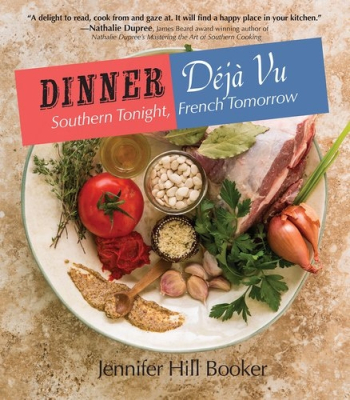
Jennifer Booker
Pelican Publishing Company
Hardcover $28.95 (208pp)
978-1-4556-2292-4
Even chefs want to save precious time and money on groceries, a tricky balancing act when dining standards are high, but Jennifer Hill Booker has blazed such a trail to the stove. Her second cookbook, Dinner Déjà Vu, blends both sides of her culinary background (Southern American with French classical training) with her concept of shopping once for ingredients to be used in two different treatments. With the detailed shopping lists at the end of the book, one can plan to make Southern style Pan-Seared Duck Breast with Whiskey Sauce one night, and use the rest of the bird to make Duck Confit in the French manner the next. The same principal applies to desserts, vegetables, and even cocktails, which is sure to please anyone with odd assortments of half-empty liquor bottles from trying out a new drink for a dinner party.
Booker sees many commonalities between Southern cooking and rustic French fare, including an emphasis on seasonal ingredients, use of game and fresh herbs, and simple cooking methods like braising and roasting to coax out maximum flavor. It is easy to compare the two cuisines with subsequent recipes and to see that both foodways share a love for such homey items as rabbit, pigs’ feet, and chicken livers. The book cleverly denotes a French-inspired recipe with a blue fleur-de-lis in the top corner of the page, while Southern recipes get a white-on-red star.
The ability to save time in the kitchen depends on a well-stocked larder, and there are many recipes for kitchen basics, such as sauces and spice blends, and a chapter on pickles and conserves to fill it up. Many recipes are easy enough to follow, but for others involving trickier techniques, How-To Guides step in with multiple photos and detailed instruction on such things as how prepare and eat Blue Crabs or make Pork en Croute.
Color photographs by Deborah Whitlaw Llewellyn add extra verve. From her whimsical portrait of Booker with a bouquet of collard greens to shots of the chef’s dishes served up in cast-iron skillets and vintage plates on worn wooden counters, these compositions evoke country cooking at its best, French or Southern.
RACHEL JAGARESKI (May 9, 2017)
Farm to Table Asian Secrets
Vegan & Vegetarian Full-Flavored Recipes for Every Season
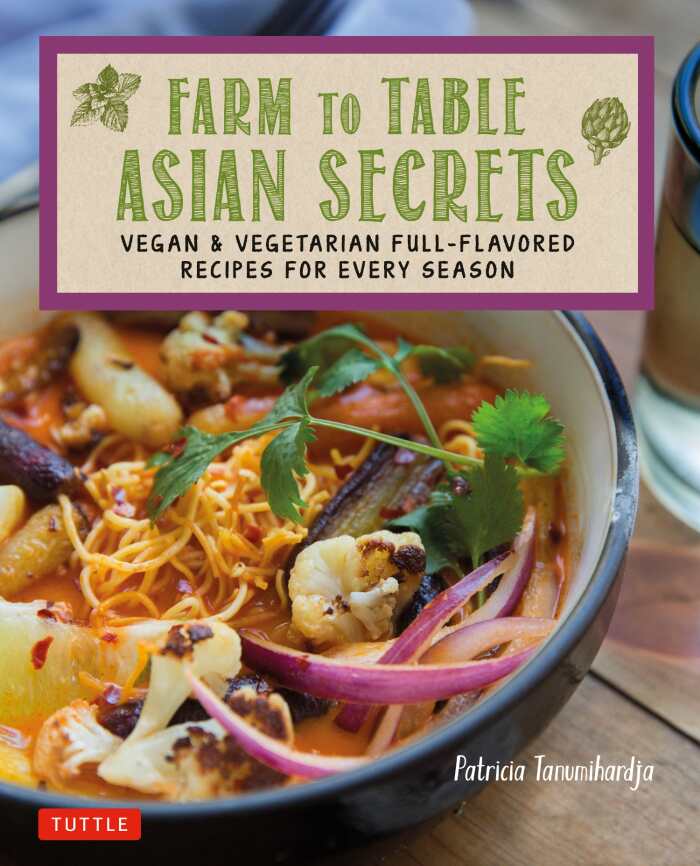
Patricia Tanumihardja
Tuttle Publishing
Softcover $15.95 (144pp)
978-0-8048-4723-0
Buy: Local Bookstore (Bookshop)
A Singapore native of Chinese descent, Tanumihardja has a background in classic Asian cooking techniques and a taste for multilayered, contrasting flavors. When she came to the US, she used these culinary chops to incorporate unfamiliar vegetables, like beets and asparagus, into her kitchen repertoire. Meat plays a “peripheral role” in the Asian diet, and this vegetarian cookbook reflects this, focusing instead on the wealth of fresh produce that home cooks are increasingly dishing up from farmers markets, community-supported agriculture shares, and their own gardens.
The first chapters highlight ingredients to stock the pantry, including items found at local markets and make-at-home versions of various sauces, pickles, spice blends, and shortcut prepped versions of tofu and tempeh. Kitchen purists and adventurers, as well as those with food allergies, will rejoice in the instructions for whipping up homemade hoisin sauce, vegan fish sauce, and adjust-to-your-own-heat-level chili pastes. Photographs, sidebar tips, and easy-to-understand descriptions of how to use these ingredients are helpful, as many may be unfamiliar with how to use some Asian ingredients, such as black vinegar or preserved radish.
Vibrant photographs accompany nearly all the subsequent recipes, organized seasonally to ensure best use of produce when it is freshest and cheapest. The table of contents also notes which recipes are vegan and/or gluten-free. From spring recipes that awaken hibernating taste buds, like Vegetable Soup with Rhubarb and Wokked Romaine Lettuce, to summer and autumn dishes that incorporate the riotous profusion of the harvest, like Butternut Squash Pot Stickers, this cookbook offers many imaginative, healthy, and delicious ways to eat more veggies, Asian-style, throughout the year.
RACHEL JAGARESKI (May 9, 2017)
Salted and Cured
Savoring the Culture, Heritage, and Flavor of America’s Preserved Meats

Jeffrey Roberts
Chelsea Green Publishing
Hardcover $27.00 (288pp)
978-1-60358-660-3
The wave of interest in artisanal and fermented foods has made locally crafted cheeses, beers, and pickles a hot commodity at restaurants and farmers markets. Now preserved meats are bleeping bright on food lovers’ radar—those salted, cured, and smoked meats traditional in most cultures, but which had fallen out of favor with health-conscious Americans in recent decades. Jeffrey P. Roberts, a Slow Food activist and food historian, debunks these fears about cholesterol and nitrates, and surveys the renaissance in locally produced salumi and charcuterie throughout the United States.
Part history, part travelogue, Salted and Cured documents how farmers, butchers, and chefs nurture each other in the production of high-quality, sustainably sourced preserved meats in a variety of cultural and regional traditions. The author used his myriad connections to research a porkophile’s dream journey, investigating the making of country hams in Virginia, the boudin and andouille sausage of New Orleans, the wurst of German and Slavic butcher shops of New York City, and the glories of the Midwestern meat-packing capitals.
As more restaurant patrons and home cooks turn up their noses at the foodstuffs of industrialized agriculture, demand for meat that has been locally and humanely raised has increased. These products take time to age and cure properly and are most often sourced from small farms with slower-growing heritage breeds: a recipe for how production is currently far outstripped by public demand. Add in the rediscovery of what food writer Anthony Bourdain dubs “the nasty bits” (offal and other snout-to-tail parts of the piggy carcass), utilized lovingly and most fully in sausages and salamis, and you can see why these preserved meats are so popular today.
An extensive bibliography, endnotes, photographs, and a list of producers offer opportunities to further explore unfamiliar types of meat products. The glossary at the back also helps reinforce the differences between salami and salumi, lardo and lomo, and all the spectacular meat treats in between.
RACHEL JAGARESKI (May 9, 2017)
Quick Keto Meals in 30 Minutes or Less
100 Easy Prep-and-Cook Low-Carb Recipes for Maximum Weight Loss and Improved Health
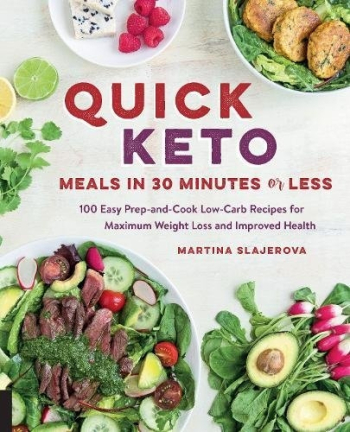
Martina Slajerova
Fair Winds Press
Softcover $24.99 (192pp)
978-1-59233-761-3
Buy: Local Bookstore (Bookshop)
For those who have been stymied in the past trying to follow a low-carb diet, Quick Keto Meals may motivate them to try again with its bounty of colorful, flavorful recipes. The self-professed science geek advocates a ketogenic diet to regulate the hormones that control appetite and burn fat rather than sugars for energy. This approach is perfect for those on a gluten-free regimen, or anyone who wants to boost metabolism or trim their waist without feeling deprived. While starchy and processed foods are verboten, there are plenty of proteins, fats, dairy, nuts, and even some decadent sweets to savor.
The key to Slajerova’s approach is discipline in maintaining portion control and a weekly kitchen prep routine so that one can draw from stashes of pre-chopped vegetables, crispy bacon, soaked and dehydrated nuts, homemade condiments, and baking mixes to speed up mealtime preparations during the busy week. Each recipe is labeled with detailed nutritional information about whether they are vegetarian or free of nuts, dairy, or eggs.
While there are familiar low-carb options like main-dish salads and frittatas, the majority of the recipes are novel and delightful un-diet-like: Full English Breakfast (the traditional toast and baked beans are swapped out for avocado and spinach), Easy Chicken Korma (served with steamed cauliflower bits instead of basmati rice), and Beef Arrabiata Ragu (sautéed spiralized zucchini “zoodles” replace carb-rich pasta). The author’s kitchen experimentation fills the dessert cart with keto-friendly takes on brownies, raspberry cheesecake, and even Tiramisu!
There’s a nice blend of ethnic dishes to choose from; some draw from Slajerova’s Czech heritage while others rework her partner’s Greek heirloom recipes. Breakfast is given a healthy keto makeover with such temptations as a glazed coconut flour pancake with cinnamon swirl, and many fun, single-serve meal ideas are easy enough to apportion and pack for lunch, like Ham and Cheese Egg Muffin in a Mug or Buffalo Chicken Salad in a jar. With these kinds of enticements, enhanced by the author’s many photographs, there is motivation aplenty to dive into a healthier way of eating.
RACHEL JAGARESKI (May 9, 2017)
Fiery Ferments
70 Stimulating Recipes for Hot Sauces, Spicy Chutneys, Kimchis with Kick, and Other Blazing Fermented Condiments
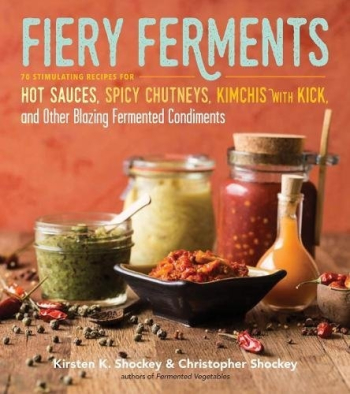
Kirsten K. Shockey
Christopher Shockey
Storey Publishing
Softcover $24.95 (272pp)
978-1-61212-728-6
Buy: Local Bookstore (Bookshop)
Fermentation is an ancient method of preserving the harvest that has undergone a revival as a tasty way to receive the health benefits of probiotic cultures and enzymes. But the Shockeys aren’t just looking to replicate great-grandma’s sauerkraut recipe; they are excitingly inventive alchemists who concocted novel ways to ferment sixty-four different vegetables and herbs for their first cookbook and now blast out 110 more recipes for spicy condiments and sauces in their latest publication, Fiery Ferments.
Chiliheads will find their favorite peppers well represented in this cookbook, but other heat sources are explored too, including galangal, horseradish, cubeb, long pepper, and the delightfully named grains of paradise. The authors researched condiments from cultures as diverse as Hawaii and Bulgaria, and recount their many experiments, including the flops, in irreverent, casual prose.
These master fermentistas are creative recipe-developers, but they also patiently explain the basics of lacto-fermentation for newbies, from the pros and cons of various containers and lids, to the techniques for making pepper pastes and mashes, brines, kimchis, and mustards. Many photographs guide the way, including the immensely reassuring ones in the Fermentation Doctor addendum that diagnoses unsettling sights, like “when brine looks like snot,” “lava flow,” or the dreaded “bulging lids” (all three are actually not big problems).
Adventurous and health-conscious cooks will love to play with these recipes, and they can even adjust the heat index, which is indicated by a thermometer in the top corner of each recipe page. Whether it’s Rhubarb Achar, a pickled relish inspired by Nepalese flavors, or Fermented Nopal Salad, there’s a new favorite condiment calling out for kitchen experimentation that is “fun, a bit crazy, and full of flavor.”
RACHEL JAGARESKI (May 9, 2017)
Full Moon Suppers at Salt Water Farm
Recipes from Land and Sea
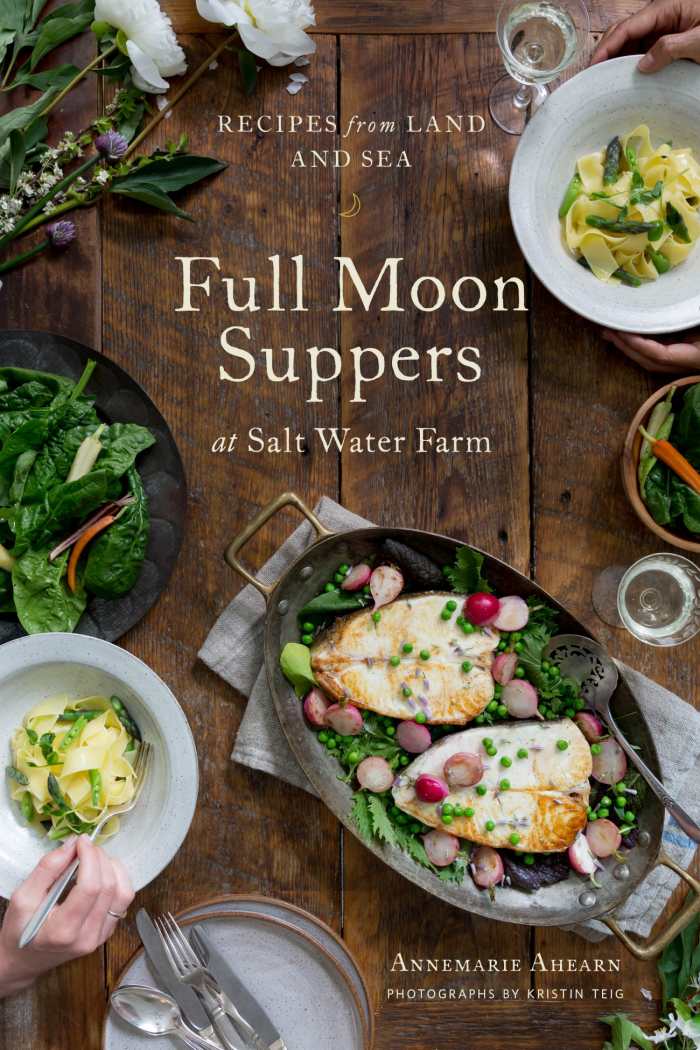
Annemarie Ahearn
Roost Books
Hardcover $35.00 (240pp)
978-1-61180-332-7
Buy: Local Bookstore (Bookshop)
When Annemarie Ahearn was a teenager, she was dismayed by her parents’ decision to relocate from Wisconsin to build a house on a boggy former sheep farm on the Maine coast. Ahearn’s post-college mindset morphed over time, and eventually she planned a cooking school and demonstration farm on her parents’ land. Salt Water Farm, named after an E. B. White essay, is the happy result, where Ahearn teaches, forages, cultivates, and hosts sold-out monthly suppers for twenty.
Each of these feasts features locally sourced foods and New England flavors, and honors aspects of Native American symbolism. January’s Full Wolf Moon supper reinforces gratitude for warm hearths and bellies full of comforting, slow-cooked foods redolent of cream, cinnamon, and citrus, whereas August’s Full Corn Moon celebrates a riotous vegetable bounty that calls for a simpler touch in the kitchen. Clearly explained recipes for every supper course, from cocktails to desserts, are enhanced with photos of the finished result, and occasional sidebars add information on cooking methods and recipe variations.
What makes this cookbook so distinctive, however, is Ahearn’s thoughtful writing. Her introduction to each monthly supper chapter is an ode to the rhythm of the seasons on the New England coast, to the area wildlife, livestock, and plants, and to seasonal chores. It is clear that her menu mojo is keenly attuned to these interconnections. Her beginning chapter, “How to be a Graceful Host,” is also a sensitively written playbook for replacing the frazzle with orderly progression of kitchen prep and the simple joy of having an uninterrupted day of cooking capped with the reward of feeding others well at your table.
RACHEL JAGARESKI (May 9, 2017)
L.A. Mexicano
Recipes, People & Places
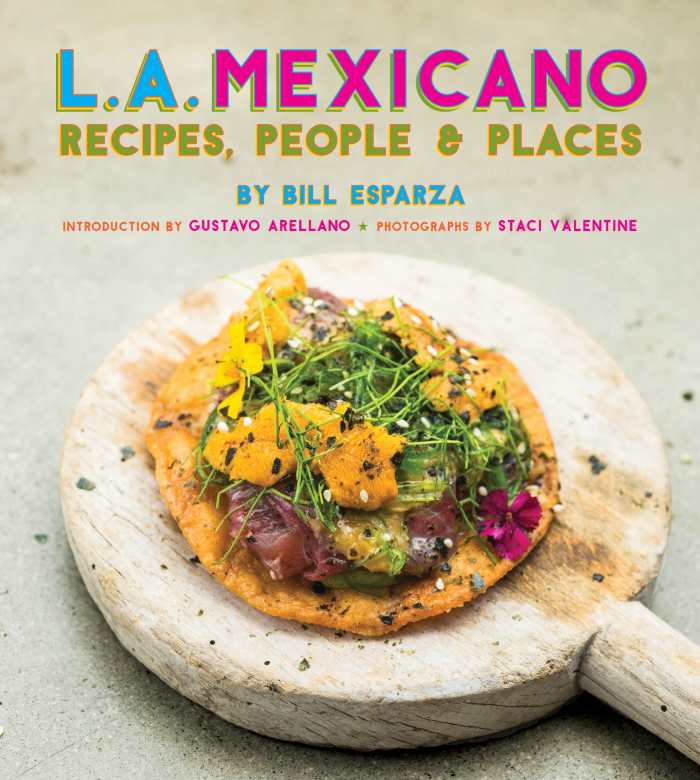
Bill Esparza
Staci Valentine, photographer
Prospect Park Books
Hardcover $29.95 (240pp)
978-1-945551-00-0
It’s a zig-zag journey with author Bill Esparza, redolent of chiles, citrus, and freshly made tortillas, to sample the dazzling varieties of Mexican-American cooking through sprawling Los Angeles. Forty profiles of cooks and artisan producers, food highlights of each neighborhood, recipes, food and cultural history anecdotes, and color photos of markets, food trucks, landmarks, and street murals all document an exciting coming of age for this regional cuisine. The story of Mexican food in America has been “an asymmetrical narrative told by outsiders,” overlooking a food scene that was largely enjoyed only by other Latinos.
The book covers a lot of ground, but the “Magellan of Menudo” is an expert guide; he neatly classifies the food scene into its subspecies. Pocho (once a disparagement but now embraced by Chicanos) describes the old-school eateries, like Ciro’s, famous for huge portions of rice, beans, enchiladas, and burritos slathered in sauce, which “bind the community together in a tapestry of melted cheese.” More authentically Mexican, and newer on the scene, are the restaurants and entrepreneurs specializing in food from Mexico’s thirty-two diverse regions. Oaxaca is represented by Soledad Lopez and her pioneering import business and restaurant which satisfied LA’s appetite for such items as tlayudas, grilled tortillas topped with beans, lard, avocado, chorizo, and stringy Oaxacan cheese.
The innovators of the new Alta California cooking are discussed here too. There’s Wes Avila, who makes sought-after street tacos with fresh combinations of ingredients and fine-dining techniques, and Tommy Ortega, who reinterprets Mexican haute cuisine, like his signature Puerto Nuevo Lobster, blanched, grilled, and served with a smoky tomatillo sauce. Finally, the book discusses other baristas, bakers, brewmasters, artisanal food makers, food trucks, and markets that are all contributing to this renaissance.
Esparza is knowledgeable, passionate, and fiercely protective of the LA Mexicano food scene. He bristles at food writers, restaurant owners, and diners that have not valued Mexican restaurant workers or their cuisine. Rick Bayless is also singled out several times; Esparza views his ascendancy as America’s best-known Mexican food authority as just another Anglo appropriating minority culture.
More positively, the author champions the members of the LA food community who are reconquering their Mexican American culinary inheritance and forging a chef culture that elevates Mexican-American cooking to its rightful place in the pantheon of great world cuisines.
RACHEL JAGARESKI (May 9, 2017)
Rachel Jagareski

